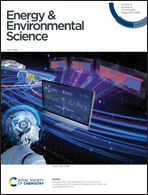Rational design of anti-freezing electrolyte concentrations via freeze concentration process†
Abstract
Electrolyte concentration is crucial for low-temperature aqueous batteries (LTABs) as it directly dictates electrolyte freezing point. However, the conventional approach for identifying suitable concentrations relies on determining freezing points of a large number of concentration combinations in the given H2O–solute system, which is inefficient, particularly for multiple-solute systems. Here, we propose an approach to efficiently and rationally design anti-freezing electrolyte concentrations via the freeze concentration process. Freeze concentration is a process of concentrating dilute solution by precipitating ice or hydrates at target low temperatures (Tt). For single-solute systems, the frozen concentrated electrolyte (FCE) extracted from the liquid–ice mixture has, by nature, the lowest concentration (therefore the lowest cost) that remains unfrozen at Tt. For multiple-solute systems, instead of testing a large number of concentration combinations, the proposed approach can directly determine suitable concentrations via one freeze concentration experiment at Tt. As a demonstration, we successfully designed FCEs in H2O–LiCl, H2O–NaClO4, and H2O–NaClO4–NaCF3COO systems, and demonstrated superior performance in Li-based LiMn2O4//3,4,9,10-perylenetetracarboxylic diimide (PTCDI) and Na-based Na1.4Co[Fe(CN)6]0.84·2.5H2O//PTCDI full cells. This work provides a universal and efficient strategy to design electrolyte concentrations for LTABs.



 Please wait while we load your content...
Please wait while we load your content...